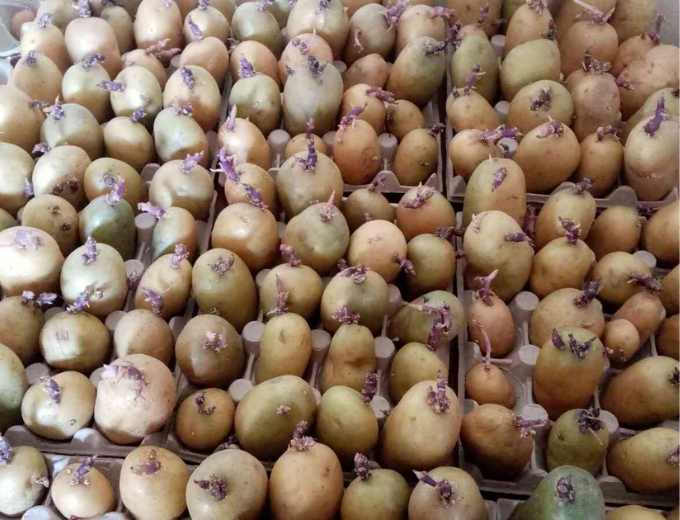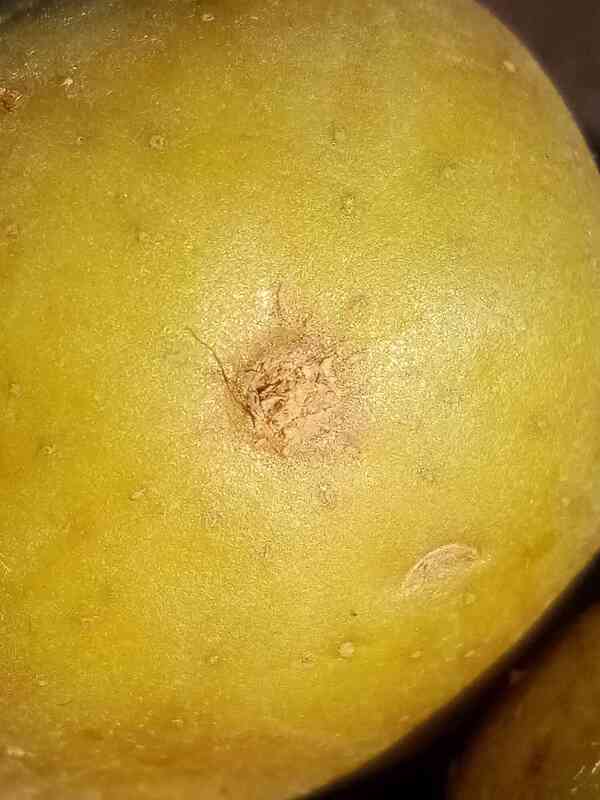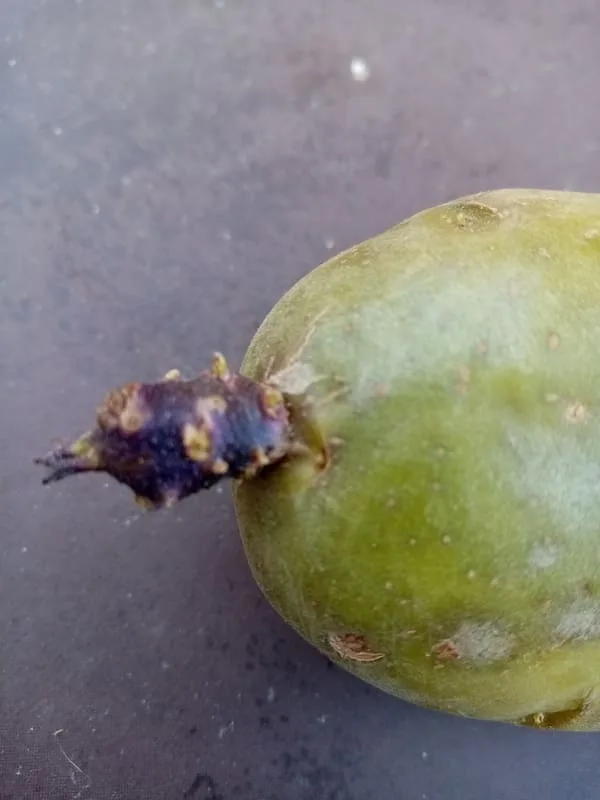Want to know how to get potatoes to sprout eyes faster? The secret you’re looking for is a warm temperature plus ethylene gas.
In an ideal scenario, you’ll purchase your seed potato early and have 4 to 6 weeks to sprout them. But if it’s already time to plant potatoes outdoors, don’t worry, there is a way to speed up sprouting.
When you’re eager to get your seed potatoes in the ground, waiting for potatoes to sprout eyes in their own sweet time can set your planting schedule back by a month or more.
That missed month could be the difference between a successful harvest and a whole lot of wasted effort if you’ve got a short growing season, where every day counts.
And if, like me, you’re growing in an area prone to potato leaf blight, you need to plant potatoes as early as conditions allow and harvest them before warm, wet weather allows blight to take hold.
In this post I’m going to give you a method you can use to speed the sprouting process along so you can plant your potatoes as soon as possible.
Let’s jump in.

How To Get Potatoes To Sprout Eyes Faster
At the right temperature, potatoes will break dormancy and begin to sprout.
While potatoes will reliably sprout when temperatures are at least 10°C (50 °F) they’ll take up to 6 weeks to get there. Which is fine if you’ve got time to wait.
But when you can’t wait that long, increasing the temperature will speed sprouting along.
When you place your seed potatoes in an environment heated to 15°C – 20°C (59°F – 68°F) sprouting should be faster.
And for an extra speed boost, you can expose your seed potatoes to ethylene gas.
Potatoes produce their own ethylene as they begin to break dormancy, but it’s a tiny amount. Luckily, there’s a simple way to give them more ethylene.
How?
Ethylene gas is produced when some fruits ripen. If you place these ethylene producers next to your potatoes for 24 -72 hours, they’ll sprout faster.
Ethylene producers include:
- Apples
- Avocados
- Bananas
- Cantaloupe
- Kiwi
- Peaches
- Pears
- Peppers
- Tomatoes
The best ethylene producers are apples and bananas, and both should be readily available at the grocery store in late winter/early spring.
The Fastest Potato Sprouting Method
Egg boxes are ideal for holding potatoes while they sprout. If you don’t have enough egg boxes, then any cardboard box or plastic tray will work. You just need a container that holds the potatoes the right way up.
Potatoes have 2 ends. The rose end, which is where the potato was attached to the plant. And the eye end, which is where the sprouts will emerge.
Place your seed potatoes rose end down. You can tell which end is the eye end because it has a small scar. The scar won’t look as big as the one in the photo below because this one is zoomed in.

If you only want to use the higher temperature spouting method, all you need to do now is set the potatoes in daylight in a warm room at 15°C – 20°C (59°F – 68°F).
Place a small bowl of water nearby to increase the humidity so the potatoes don’t lose too much moisture.
Add Ethylene
If you want to try using ethylene, you’ll need to do a little more setting up.
Because ethylene is a gas, it’s going to escape into the room instead of remaining concentrated next to your seed potatoes unless you trap it.
To trap the gas, you’ll need a box and a transparent plastic bag.
Place your potatoes in the box along with several bananas or apples. Cover the top of the box with the plastic bag. Poke a few holes in the bag to allow for some air exchange.
This method will keep most of the ethylene gas close to your potatoes.
There’s no exact science to this, but 3 or 4 bananas should be enough for 20 seed potatoes.
I estimate 3 or 4 will be enough because I use the ethylene from bananas to ripen green tomatoes, and that’s how many I use for 15 to 20 tomatoes.
Remove the fruit after 24 – 72 hours. This is important because ethylene has 2 effects on potatoes.
A short exposure to ethylene speeds up potato sprouting.
Rylski, Irena, Lawrence Rappaport, and Harlan K. Pratt. “Dual effects of ethylene on potato dormancy and sprout growth.” Plant Physiology 53.4 (1974): 658-662.
But prolonged ethylene exposure inhibits sprouting. In fact, commercial growers use ethylene in their potato stores to prevent sprouting in the harvest they’re storing for market.
In the study linked above, researchers recommend 72 hours as the maximum period the potatoes should be exposed to ethylene.
Once 72 hours have passed, place the potatoes in normal air for the rest of the sprouting period.
Don’t Let The Sprouts Get Too Long
Because you’re using a higher temperature to sprout your potatoes, you need to keep an eye on them.
The reason we normally sprout potatoes at around 10°C (50°F) is because higher temperatures result in more rapid sprout growth.
Left in a warm environment, the sprouts will grow too long and they can break off when you plant them in the ground.
Check on their progress each day and as soon as the sprouts are 1 cm to 2 cm long (1/2″ to 1″ long) plant them right away (as long as your outdoor temperatures are warm enough)
If you can’t plant them right away, move the potatoes into a cooler room to slow down the sprout growth rate.
Can You Plant Potatoes Without Sprouting Them?
Of course!
Think about what happens to potatoes naturally. The tubers grow underground, and they stay underground unless they’re dug up by humans or eaten by foraging animals.
Mature tubers go through a period of dormancy before they spout new growth. That’s why you can’t immediately replant potatoes from your early summer harvest to get another crop.
Dormancy duration depends on potato variety and temperature. Most potato varieties have a natural dormancy period of 4 to 8 weeks. During this period, they won’t sprout, no matter what you do.
Once that period has passed, if the temperature is warm enough, they’ll sprout. But if the temperature is too low, they stay fast asleep.
(Commercial growers store potatoes at 4°C (39°F) to achieve the longest dormancy period possible).
If you’ve grown potatoes before, you may be familiar with volunteer potatoes. Volunteer potatoes grow from tubers we miss when we harvest our potato crops.
But those missed potatoes don’t start growing right away.
In my garden, volunteer potatoes usually begin to appear in late March. Which means they’ve been dormant for 6 months.
Those potatoes come up and (if I don’t remove them) grow into healthy, productive potato plants – no sprouting required.
In the (many) years when I haven’t been as organized as I should have been, I’ve purchased seed potato and planted it right away without sprouting the seed potatoes first.
Did the potatoes grow? Yes. They took longer to emerge from the ground, but they grew fine otherwise.
So, if you’re late picking up your seed potato and you want to plant them the same day, you can do that. Unsprouted potatoes will grow if you plant them in the ground. They’ll just take longer to get going.
Is It Worth Sprouting Potatoes Before Planting?
If potatoes grow without sprouting, then why go to the bother of sprouting them? Here’s why.
- You’ll get an earlier start to your growing season.
- Plant growth will be more consistent.
- The potato canopy will close sooner.
- You’ll enjoy an earlier harvest.
- There’s a better chance of avoiding potato leaf blight.
Let’s explore each one of those reasons.
Earlier Start To Your Growing Season
By sprouting your potatoes, they’re already growing when you plant them out in your garden.
The earliest you can plant potatoes out in your garden is 2 to 4 weeks before your last spring frost date.
If you plant unsprouted potatoes, you’ve got to wait for the potatoes to break their dormancy, which can take several weeks. And then they’ll take a few more weeks to emerge from the soil.
But when you plant potatoes you’ve already sprouted, there’s no dormancy period to hold the potatoes back.
Sprouting your potatoes in late winter/early spring gives you a head start on the season.
More Consistent Plant Growth
When you plant sprouted potatoes, you can be confident you’ll get a potato plant from each seed potato.
That’s not true of unsprouted potatoes because some potatoes will be duds which don’t produce any growth.
When you plant potatoes without sprouting them first, you’ll inevitably end up with empty spaces in your rows. Then if you’ve got any seed potato left over, you’ll pop the spares into the gaps.
This leads to uneven growth affecting your potato canopy, and your earthing up schedule.
A Better Potato Canopy
A potato canopy forms when the foliage on your potato plants is large enough to cover the growing bed.
A closed canopy results in less weed growth because the canopy shades out the weeds, depriving them of the light they need to grow.
When you’ve got fewer weeds taking nutrients and moisture away from your potatoes, you’ll get a better yield at harvest time.
By pre-sprouting seed potato, you’ll get faster and more consistent canopy development.
Earlier Harvest
By sprouting potatoes before you plant them, you’ll be able to begin your harvest a few weeks earlier.
An earlier harvest obviously means you won’t need to wait as long to enjoy your delicious homegrown potatoes. But there are a couple of other benefits too.
By getting your potatoes out of the ground earlier, you free up that growing space for a follow on crop like winter squash.
Being able to harvest potatoes a few weeks earlier also gives you a better chance of avoiding potato leaf blight (Phytophthora infestans).
Potato blight is a fungus-like organism that thrives in warm, wet weather. If you harvest your potatoes before the blight window opens, you’ll get a good crop.
But if your potatoes are still maturing when blight strikes, the fungus will soon destroy the potato foliage and tuber growth will stop, resulting in a smaller yield.
In the worst case, the blight will reach the tubers themselves and cause rot to set in. These tubers won’t store well.
Can You Sprout Green Potatoes?
We all know that we shouldn’t eat green potatoes because of the concentration of toxic solanine in them. But while solanine can hurt us, it isn’t a problem for the potato.
A green potato will happily sprout as you can see in this photo.

The green seed potato won’t have any harmful effect on plant growth, and the plant will produce completely normal potatoes.
Should You Remove Excess Potato Sprouts?
Yes, and no.
Potatoes come in two main types.
- Determinate – first and second early varieties
- Indeterminate – main crop varieties
With determinate varieties that mature in 70 to 90 days, you shouldn’t remove any sprouts. These potatoes naturally produce lots of smaller potatoes from their multiple stems. If you remove eyes or sprouts from determinate varieties, you’ll get fewer potatoes at harvest time.
But if you’re growing main crop potatoes, you’ve got a choice. You can allow multiple eyes to sprout, in which case you’ll get lots of small potatoes from each plant.
If you want large potatoes, though, remove all but the two strongest buds, so the plant puts all of its energy into making large potatoes on those stems.
Final Thoughts
Sprouting potatoes gives you a head start on the growing season while it’s still too cold to set the potatoes in the ground.
When the growing season is already underway and you need to sprout seed potatoes in a hurry, increase the temperature and expose the potatoes to some ethylene gas from ripening bananas or apples.
Keep an eye on their progress and be ready to plant the potatoes once the shoots are 1 cm to 2 cm long (1/2″ to 1″ long).
Thanks for reading: How to get potatoes to sprout eyes faster. I hope you get a great potato harvest!

